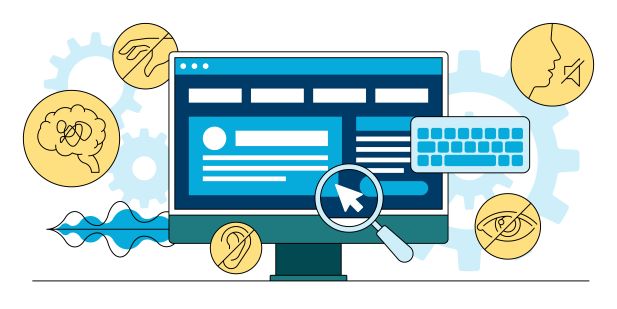
Nonprofit Web Design: Best Practices for Accessibility

Your nonprofit’s website might be visually appealing, but is it accessible for everyone?
Web accessibility is a growing initiative to make the web more inclusive for people of all abilities. This way, people with visual, hearing, or other impairments can still engage with your content and connect with your organization’s cause. Prioritizing accessibility is also advantageous to people without disabilities, since a website that is easier to navigate creates a better user experience for everyone.
With these benefits in mind, it’s in your nonprofit’s best interest to put accessibility at the forefront of its digital strategy. Incorporate the following tips to optimize your nonprofit’s web design so it’s more accessible:
- Use a CMS with built-in accessibility features.
- Optimize your website for mobile users.
- Prioritize simple navigation.
- Make your content legible.
A more accessible website can help your organization market itself to diverse audiences, create an inclusive culture, and grow its fundraising strategy. Let’s dive in!
Use a CMS with built-in accessibility features.
Prioritizing accessibility on your website can be time-consuming and difficult if you don’t have previous web development experience. However, a nonprofit-specific content management system (CMS) can help your organization easily incorporate accessibility features into your website—no coding required!
When looking for a nonprofit CMS, choose one that has the following features:
- Front-facing editing. An ideal CMS will allow you to add in accessibility elements without having to go into the backend of your website. With front-facing editing, you can create alt-text for non-text elements. Alt-text is simply a short sentence that describes the image for people who may not be able to see it. With the right CMS, you can add alt-text by simply highlighting or clicking on the image and adding in a brief description. Alt-text is important for accessibility because it allows people with visual impairments to understand and enjoy your non-text content. You can also use front-facing editing to quickly assign header tags and make your content more orderly, which facilitates a better reading experience.
- Accessibility widget. An accessibility widget allows users to customize your content to their specific needs. This widget should enable users to adjust the font size, change colors to greyscale, and change font type to non-serif.
- Built-in templates. Choose a CMS that comes with beautiful nonprofit web templates that prioritize organization, such as with clear headings and titles and a navigation bar above the fold. This will create a more user-friendly experience for your site visitors and keep their attention on your site.
While your CMS will be a huge help in optimizing your website, it’s your responsibility to keep up with the Web Content Accessibility Guidelines (WCAG) standards and adjust your site accordingly. The WCAG is widely recognized as the international standard for online accessibility, so do your research and work with your content management system’s support team to make sure you’re compliant.
Optimize your website for mobile users.
People are spending more time on their phones than ever, so why not make your website accessible to mobile users? A mobile-friendly website will expand your audience and make navigating your site from any device a more positive experience.
Your website should have the following user-friendly features:
- Mobile-responsiveness. Text and non-text elements, including images and videos, should appear at an appropriate size on any device. If these elements are too large or too small on a mobile device, navigating your website becomes more complicated. Your site should look equally flawless on a large computer and a small mobile screen. Most website builders offer automatic mobile-responsiveness.
- Resized pop-ups. Pop-ups might appear too large on a small mobile screen and it can be difficult for users to close them out. This can easily frustrate mobile users and cause them to leave your website. Avoid using popups, but if they’re necessary, make sure they’re adjusted for mobile devices so they can be closed out.
- Clickable buttons and accessible prompts. All links and buttons should take mobile users to the appropriate place. Forms, especially your donation page, should be fully accessible so your visitors can fill it out without any issues.
Making your website accessible to mobile users not only benefits the user experience, but it also can help your nonprofit’s fundraising efforts. According to 360MatchPro’s fundraising statistics, donation pages that are mobile friendly yield 34% more donations. Your giving page is an important part of your website, so make sure to optimize it for accessibility to raise more funds.
Prioritize simple navigation.
Easy navigation allows your site visitors to find exactly what they’re looking for, whether that’s learning more about your organization or accessing your nonprofit’s giving page.
The most important navigation element your website needs is a navigation bar. This can be positioned on the top or the side of your page; however, many websites choose to position it above the fold so users can easily locate it. Include simple titles that accurately summarize your pages in the navigation bar, such as About Us, Testimonials, and Get Involved.
To bring specific attention to important pages, such as your donation page, you can make buttons that will automatically take users to this section of your website. Consider making a bold “Donate Now” button that users can see at the top of every page of your website. This will help bring more people to your giving page and amp up your fundraising efforts.
Make your content legible.
If your site visitors can’t read or understand your content, they’ll likely leave your website, causing you to miss out on key support. To create a web design that facilitates a positive reading experience, use these tips:
- Use an easy-to-read font. Use a plain font so users can digest your information without getting frustrated. Sans-serif fonts, like Arial or Helvetica, are commonly used because of their legibility.
- Avoid technical language. If your content contains unusual words or feels too complicated, users will click away. Word your content so it can be understood by your entire audience.
- Incorporate contrast between the background and foreground. Your text should stand out from your background. Avoid a background color that is too overpowering or a text color that is too faint.
- Apply ample white space. Apply space between paragraphs and sections of your website so the different elements don’t clutter together and make reading difficult.
Users can’t take critical next steps, like donating or signing up to volunteer, if they can’t engage with your content. According to Morweb, the best nonprofit websites keep their nonprofit’s audience in mind and help them get the information they need. Structure your website design so your audience can easily access and interact with your nonprofit’s resources.
An accessible website is an important part of strengthening your nonprofit’s digital reach. By allowing more people to engage with your content, you’ll be able to grow your nonprofit and advance its mission. The right CMS can help you easily optimize your existing site or create a beautiful website from scratch that prioritizes inclusivity. Good luck!

